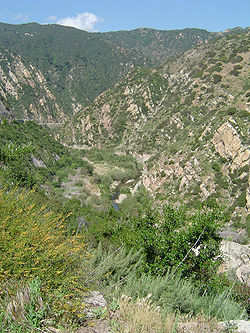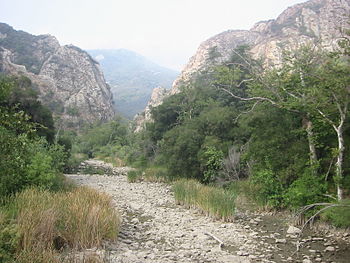- Malibu Creek
-
Malibu Creek Malaga Creek, Maliba Sequit Creek, Malibo Creek, Topanga Malibu Sequit Creek stream Malibu Creek, dry river bed, with the Goat Buttes in the backgroundCountry United States State California Region Los Angeles County Tributaries - left Medea Creek, Las Virgenes Creek, Cold Creek Source - location 4 mi (6 km) - coordinates 34°07′22″N 118°47′38″W / 34.12278°N 118.79389°W [1] Source confluence Triunfo Creek and Lobo Canyon Creek - elevation 760 ft (232 m) Mouth Malibu Lagoon then Santa Monica Bay, Pacific Ocean - location Malibu, California - elevation 3 ft (1 m) [1] - coordinates 34°01′54″N 118°40′47″W / 34.03167°N 118.67972°W [1] Malibu Creek is a year-round stream in western Los Angeles County, California. It drains the southern Simi Hills and the westernmost San Fernando Valley, flows south through the Santa Monica Mountains, and enters Santa Monica Bay east of Malibu. The Malibu Creek watershed drains 109 miles (175 km) and its tributary creeks reach as high as 3,000 feet (910 m) into Ventura County, California.[2] The creek's mainstem begins at the confluence of Triunfo Creek (below Westlake Village, California) and Lobo Canyon Creek, and flows 13.4 miles (21.6 km)[3] to Malibu Lagoon.
 Malibu Canyon in the Santa Monica Mountains
Malibu Canyon in the Santa Monica Mountains
Malibu Canyon is a chief pass though the mountains, and Malibu Canyon Road is a major north/south route connecting the coast to the inland valley. The creek starts at Malibou Lake, which is held back by the Malibu Lake Dam. Further downstream, Malibu Creek waterfalls 100 feet over the Rindge Dam, then carves its final path into Malibu Lagoon.
Contents
History
The area around Malibu Creek was for centuries a major area of Native American life, and the boundary between the Chumash tribes, who lived to the northwest, and the Gabrieliño, to the south and east, was there.
The origin of the creek's name likely derives from the Chumash term U-mali-wu, which means "it makes a loud noise there". The Spanish recorded this as 'Malibu', and this spelling appears in the Topanga Malibu Sequit land grant on July 12, 1805.[4].
Ecology
It is estimated that the Steelhead trout (Oncorhyncus mykiss) populations within the Southern California Coast Steelhead Distinct population segment (DPS) have declined dramatically from annual runs totaling 32,000-46,000 adults to less than 500 returning adult fish.[5] This estimate is based largely on the four major steelhead-bearing watersheds (Santa Ynez River, Ventura River, Santa Clara River, and Malibu Creek. Genetic analysis of the steelhead in all four of these watersheds has shown them to be of native and not hatchery stocks.[6] A sand berm across the mouth of the Malibu Creek Lagoon blocks the stream to ocean-based steelhead except during the rainy winter season when high flows breach the berm and opens access to the estuary. The fish quickly reach an impassable barrier presented by the 30 meter high Rindge Dam, restricting them to the lowest 3.2 km of more than 112 km of historic steelhead habitat.[7] The dam, originally built for water storage and flood control in 1926, no longer functions as the reservoir is completely filled with sediment. Over the past decade several government agencies and non-profit organizations have been trying to remove the dam to restore access to upstream spawning habitat. In 1997, the southern Evolutionarily Significant Unit (ESU) of steelhead trout was added to the federal list of endangered species, with Malibu Creek as the southernmost boundary. Since 1997, the protected range of this ESU has been extended to the U.S./Mexican border. The National Marine Fisheries Service (NMFS) estimates that only 500 anadromous adults remain within this ESU (NMFS 2007). In summer, 2006, there was a massive die off of native and exotic fish and invertebrates in Malibu Creek, thought to be due to a combination of pollution, high temperatures and low oxygen. The steelhead trout population fell to zero by November, 2006. Fortunately, surveys in summer 2008 documented five returning adult steelhead (over 50 cm) and over 2,200 smolts (under 10 cm) were also recorded.[7]
The rare plant Malibu baccharis (Baccharis malibuensis) is endemic to the Malibu Creek drainage.[8]
Malibu Creek Watershed
Malibu Creek has several tributaries draining the Santa Monica Mountains. These include streams draining to Lake Sherwood, and thence via Potrero Valley Creek to Westlake Lake, then down Triunfo Creek to its confluence with Lobo Canyon Creek which is the origin of Malibu Creek. Amongst many other tributaries are Medea Creek, Las Virgenes Creek and Cold Creek. Medea Creek and Malibu Creek join to form Malibu Lake. Further downstream Las Virgenes Creek joins Malibu Creek at Malibu Creek State Park. In this park, the Rindge Dam becomes a 100-foot (30 m) waterfall, emptying into a perennial deep pool. Eventually the creek empties into the 13-acre (53,000 m2) Malibu Lagoon.
Parks
Parkland in the creek's drainage include the National Park Service's Paramount Ranch, Malibu Creek State Park, and Tapia Park. The Gillette Ranch, once owned by King Gillette and later by Soka University, is being converted to parkland and a multi-million dollar visitor center is being built.[9] Numerous movies and TV shows were filmed in the area, such as Planet of the Apes and M*A*S*H.
See also
- Malibu Creek State Park
- Rindge Dam
- Steelhead Trout
- The Rock Store
References
- ^ a b c U.S. Geological Survey Geographic Names Information System: Malibu Creek
- ^ "Malibu Creek Watershed". Malibu Creek Watershed Council. http://www.malibuwatershed.org/2ndLevel/aboutws.html. Retrieved June 13, 2010.
- ^ U.S. Geological Survey. National Hydrography Dataset high-resolution flowline data. The National Map, accessed March 16, 2011
- ^ Erwin Gustav Gudde (1974). California Place Names. University of California Press. p. C-190. http://books.google.com/books?id=M-22djGNuhwC&pg=SL3-PA190&lpg=SL3-PA190&dq=gudde+malibu&source=bl&ots=-KPF1AVQNQ&sig=VeugsrebjdB9IKi0UdkXgLWJddA&hl=en&ei=io8UTI7YEMLsnQec0YCVDA&sa=X&oi=book_result&ct=result&resnum=1&ved=0CBIQ6AEwAA#v=onepage&q=malibu&f=false. Retrieved June 13, 2010.
- ^ 2007 Federal Recovery Outline for the Distinct Population Segment of Southern California Coast Steelhead (Report). The National Marine Fisheries Service. Sept., 2007. http://swr.nmfs.noaa.gov/recovery/FINAL_2007_Recovery_Outline_for_the_DPS_of_Southern_CA_Coast_Steelhead_091407.pdf. Retrieved June 13, 2010.
- ^ Anthony J. Clemento, Eric C. Anderson, David Boughton, Derek Girman, John Carlos Garza (2009). "Population genetic structure and ancestry of Oncorhynchus mykiss populations above and below dams in south-central California". Conservation Genetics: 1321–1336. http://www.springerlink.com/content/7305l85175847n20/fulltext.pdf. Retrieved 2011-06-11.
- ^ a b Rosi Dagit, Stevie Adams, Sabrina Drill (April, 2009). "Die off and current status of southern steelhead trout in Malibu Creek, Los Angeles County, USA". Bulletin Southern California Academy of Sciences. http://findarticles.com/p/articles/mi_hb038/is_1_108/ai_n32145995/?tag=content;col1. Retrieved June 12, 2010.
- ^ Flora of North America: B. malibuensis
- ^ Calabasas365: King Gillette Ranch Getting an $8.4 million Visitor Center
External links
Categories:- Rivers of Los Angeles County, California
- Santa Monica Mountains
- Malibu, California
- Rivers of Southern California
Wikimedia Foundation. 2010.

